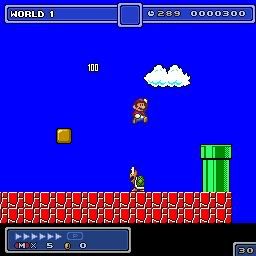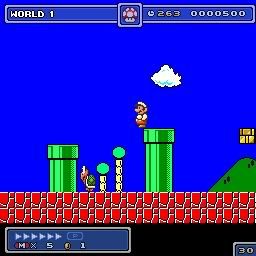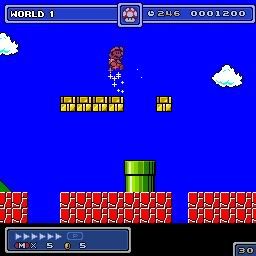Let me give you a little history lesson to start off things. Don't need to have the shit hitting the fan all at once. Back during the 64 bit-era, when Sony's Playstation and Nintendo's Nintendo 64 were at it, Namco started releasing compilations of their classic arcade games, titled Namco Museum. These were accurate re-creations of their titles, both ones that made it to the States and PAL territories, and ones that didn't. The first one, released in 1995, included several of their well-known worldwide titles, and just for shits and giggles, they splotched in Toypop, one of their Japanese-exclusive games, which I feel as if stuck out from the rest of the crowd because it wasn't relatively known outside Japan. But otherwise, it was a decent title for the PS1 library, and so, Namco followed up with four more volumes released over the late 90's. Each one contained roughly five to seven games, with some of the titles serving the same fate as Toypop and not being relatively-known outside Japan. The second volume featured a simliar layout to the first, the third and fourth ones took their own design, and the fifth one was made less linear, spreading the games around the main museum HUB. Every volume featured a ton of bonus content based on the game's original Japanese releases where you can view promotional flyers and merchandise available during the time of the game's original release. Yea I know I repeated a few things there, but the more the better!
After the original "quintoligy" (or however you say it), Namco released a sixth volume excluvesely in Japan, known as Namco Museum Encore that broke several traditions of the preceding five volumes. Gone was the virtual museum- instead they put you in some sort of black room with nothing but stars and the cabinets of the games all in one room (at least, I think that's how it went. There are only a few screenshots, and not enough good hard evidence to see what really was in Encore), and gone was also the bonus features and content (once again, dunno much about Encore).
But anyways, fast forward to the early 2000's, following the N64 and Dreamcast Namco Museum titles, which are nothing special, aside from being a compilation of Namco's most popular and recognized games. Here we saw the 128-bit console multi-platform Namco Museum, which was a vastly updated version of the N64/Dreamcast versions, containing several additional games, the main ones that got my attention were the "Arrangement" titles, which included remakes of Pac-Man, Dig-Dug, and Galaxian, which were previously seen in "Namco Classics Collection" alongside the games they were initially based on. THis collection for the first time, contained a non-arcade title, Pac-Attack. Then, came Namco Museum 50th Anniversary, celebrating 50 years of Namco's career as a toy company. This one once again was a compilation of some of their most well-known titles released worldwide, but was much bigger, and rather than doing accurate remakes of the titles, they instead did a near-perfect emulated version, and stays very true to the originals. Battle Collection was somewhat of the same ordeal, but had more titles, and brought in new game menus per title where the player can choose their starting level, and therefore continue progress after getting a Game Over. This one also had a different set of Arrangement titles separate from the ones in Classics Collection, that since following Battle Collection have become known as the "Remix" series. These "Remix" titles I felt were weaker than the "Arrangement" variants. Afterwards, there weren't any new titles released in the Museum lineup. Nowadays they seem to be focused on just releasing previously-featured arcade titles just to get them on other platforms, and don't release any of their Japanese-only or rare titles on their recent collections. Nor do they seem to be willing to just throw in a large pack of their hits into one disc. Well that's perfectly why I'm here, to tell you how I feel a Namco Museum should be done, and done right.
Well, it's kind of difficult to explain, but let me break it up for you. This Museum title, if it ever existed, would contain many arcade titles from Namco's past years, all perfectly emulated, and all in their original language (with some games having alternative ROMS for different languages). It goes back to the museum format of the original PS1 installments, but the games are now laid out on three different floors based on their overall popularity or obscurity. The first floor contains games based on Namco's most well-known titles, the second floor contains some of Namco's lesser-known games that have a decent fan-following, and the third floor contains games there are extremely uncommon outside of Japan, and didn't get releases on a Namco Museum. On each of these floors, you enter doors that lead to the basic gallery rooms where you view the game's bonus content, but rather than just items based on the Japanese releases, this compilation goes further to include items from other releases of the same game outside of Japan (if available). Then at the end of the hall is the room where the game's upright or cocktail cabinet is displayed. The "game" rooms, and their corresponding gallery rooms seen from the original PSX games are also seen here, but enhanced greatly with better graphics and visuals. The sounds remain the same. As for the ones form Encore and other titles not in the original quintology, they are given rooms based on the game that's inside the room, and a theme that fits the game itself (mainly a remix of one specific BGM from the game). Should be easy to explain, but let's move on.
Then, there's a fourth floor that simply contains nothing but bonus content. Background music and sound effects from the games, other Namco-related scans and artowrk, and player/user records and online leaderboards for every title (of which the games need to be played in a separate mode called (Score Attack) to register scores on the worldwide leaderboards, which is each game always on default or easiest settings, both with their own list).
But let's cut the bullshit, and introduce the games. Per floor, in alphabetic order.
1st Floor:
Boscoian
Dig Dug
Dig Dug II
Dragon Spirit
Galaga
Gaplus
Galaga '88
Galaxian
Jr. Pac-Man
King & Balloon
Mappy
Ms. Pac-Man
New Rally-X
Pac-Attack (SNES version)
Pac-Attack (Namco Anthology 2 verison)
Pac-Land
Pac-Man
Pac-Man Plus
Pac-Mania
Pole Position
Pole Position II
Rally-X
Rolling Thunder
Sky Kid
Sky Kid Deluxe
Super Pac-Man
Super Xevious
Xevious
2nd Floor:
Assault
Assault Plus
Baraduke
Bomb Bee
Cutie Q
Dig Dug Arrangement
Dragon Buster
Dragon Saber
Galaga Arrangement
Gee Bee
Genpei Toma Den
Grobda
Mappy Arrangement
Metro-Cross
Motos
Mr. Driller
Ordyne
Pac & Pal
Pac-Man Arrangement
Phozon
Rally-X Arrangement
The Return of Ishtar
The Tower of Druaga*
Toy Pop
Xevious Arrangement
Valkyrie no Densetsu
*(includes Another and Darkness Tower versions from Volume 3, as ROM hacks)
3rd Floor
UPDATE: In response to Namcorules, a user on StrategyWiki, whom I've showed the post to, I've decided to add some more titles to the list, of which I intended to add but got a little carried away writing the list that I forgot to insert them. I'm not going to mark off which titles are now on this list. The reason why I had stated that some of the games would "bump up" the age rating to T/13+ if this ever became a commercial release was because of several reasons, the most notable I can think of off the bat were Wonder Momo's "panty shots" and Yokai Dochuki's heavy religious theme.
Bakutotsu Kijutei
Blast Off
Blazer
Bravoman
Burning Force
Cosmo Gang the Video
Dangerous Seed
Dirt Fox
Emeraldia
Final Lap
Final Lap 2
Final Lap 3
Finest Hour
Hopping Mappy
Kaitei Takara Sagashi
Libble Rabble
Marchen Maze
Marvel Land
Metal Hawk
Mirai Ninja
Phelios
Quester
Quester Special Edition
Rolling Thunder 2
Rompers
Souko Ban Deluxe
Tank Battalion
Tank Force
Warp & Warp
Wonder Momo
Yokai Dochuki
I am not planning to add the following games:
World Stadium, World Court, Face Off, Kyukai Douchuki, Numan Athletics, Other Namco Sports titles- All sports games. Not that I have anything against them, but I just feel that this collection would be better off without those.
Splatterhouse- I heard the game got negative reviews on various sites. But that's just according to my knowledge. I just don't have much desire to include Splatterhouse.
Four Trax, Other Namco Racing titles- Pole Posistion and Final Lap both share pretty much the same gameplay to these titles. And I feel as if there are enough racing games in this collection. Yea I'm a big fan of racing games, but still.
Galaxian^3, Xevious Sequels- There's enough shooters in this collection.
Steel Gunner, Steel Gunner 2, Golly! Ghost!, Golly! Ghost! 2- all these use the external-gun-mounted-onto-console control format.
Cosmo Gang the Puzzle- This collection already has two versions of Pac-Attack, of which CGTP's gameplay had inspired.
Knuckle Heads, Soul Edge, Soul Calibur, Other Namco Fighting titles- Fighting games. While I do enjoy playing them from time to time, the idea to add these is the same as with the sports titles.
Namco Quiz Games- I quote the Angry Video Game Nerd: "Quizzes aren't fun! Quizzes make you feel like you're in school!"
Once again, sorry if some of your favorites didn't make the list. I want to keep this collection simple and not get carried away with the games.
All games contain their original Dip Switch settings, and like I probably had said before, are all perfect emulations of their original, non-translated versions, with alternative translated ROMS for games in Japanese. More confusing games with complex objectives also include an in-game how-to/walkthrough booklet for specific games, mainly Tower of Druaga.
Please let me know your opinions if possible. Thanks much to Twitter user superfroman12 for supporting the idea, and to everyone else, feel free to spread the word.
Keep making great games, Namco!





